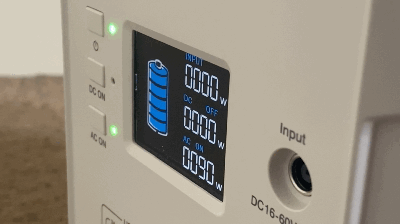More than ever, we rely on a continual supply of power in our homes and offices to, well, quite literally keep the lights on. But what happens when the lights go out? Or what happens when you travel somewhere where there isn’t a convenient power outlet for you to be able to plug into and use?
It’s at times like this that people wish they had backup power. And for years, the mainstay has been gasoline generators. But these are big, bulky, noisy, need regular maintenance, emit noxious fumes that rule out running them indoors, and then there are all the associated risks of setting everything alight with gasoline.
Enter the Bluetti EB240.
Must read: Extreme weather forecast? Essential gear for when the power goes out
The EB240 is a beast. It’s a huge heavy box with a sturdy handle on the top, and inside is 2,400Wh of LG lithium cells that can output 1,000W of AC (1,200W surge), 9A of 12V power, and four USB-A ports outputting 2A, and a 45W USB-C port.
The package is no power bank you can slide into a pocket. The box, which resembles a suitcase with a convenient handle on the top — is 37.08 x 16.51 x 36.58 cm and weighs in at an incredible 17.2 kg when all the packaging has been removed.
Despite all the power and ability, there are only three buttons on the EB240 — on/off, AC power on/off, and DC power on/off.
With so much power at my disposal, I wanted to know what I could do with it.
First off, I spent a few days using it to charge up all my smartphones and gadgets. The four 3A USB-A and one 45W USB-C PC port can handle all my devices without batting an eye. I calculated that I could recharge my iPhone 11 Pro Max around 200 times from one fully charged EB240, which is itself quite staggering.
The manufacturers claim you can recharge a normal smartphone 260+ times, and drones 27 times, and given my testing, I have no reason to doubt these figures.
For people like photographers or videographers going on a road trip, this thing would offer a lot of off-grid time.
I also tested the 1000W AC outlet, and found that they had no problems handling high loads. With a 1,000W fan heater attached as a load (a pretty brutal load), the EB240 managed a very respectable 2 hours of runtime. With a more modest 500W load, I got over 4 hours of runtime.
That fan heater could be bumped up to 2,000W, so I just had to see what happened when I tried that. Would the EB240 stutter? Would there be sparks and smoke? No, the unit simply cut power to the AC outlet, turning it back on when the load went down to 1,000W or below.
Where the load exceeds 1,000W but are less than 1,200W, the EB240 will run for 120 seconds before the overload cutout kicks in. This allows it to handle the higher load spikes when devices are turned on without cutting off.
All very controlled.
All very safe.
And exactly what I would expect from what is essentially a huge suitcase filled with lithium polymer batteries.
I was also very impressed by the EB240’s ability to operate at 1,000W load continuously.
Over the past few weeks, I’ve done a lot with the EB240. It’s been thrown into the trunk of a car, and rattled along dirt roads on off-grid trips. I’ve taken it outdoors and used it to run power tools. I’ve brought it out for a power cut.
Each and every time I’ve turned to it, it’s been ready and waiting (as long as I remembered to recharge it), and it performed flawlessly.
So, I wanted to try something a little different.
Could I use it to power my office? And if so, how long would it last?
Well, as it turns out, I know pretty well how much power my office consumes. Excluding the printer and Wi-Fi router (which live in an adjacent room) and the main lighting (which is on a separate circuit), my office uses between 50W and about 700W of power, depending on what I’m doing at the time.
Most days it’s just me, my laptop, a charger or two, and an LED desk lamp. Other times I periodically have higher loads on during the day for PCs and other items.
So I tried it, and moved my office over to running off the EB240.
As I thought it would, it worked great, and I got 20 hours of use out of it, which equated to more than two working days.
That’s impressive for a device I can carry around or take with me in the car.
And at no point while I was using it did the cooling fans come on, so it was quiet, distraction-free power. The specs say that the fan comes for AC loads greater than 400W, DC 12V loads of more than 80W, and when the input charge power is higher than 100W.
The EB240 is also pretty tough. The aluminum alloy and high-density polymer shell takes quite a battering. It is, however, worth noting that the EB240 has an IP rating of IP 21, which means that as far as liquids go, it is protected against “vertically falling drops” only, so use common sense when taking this into the outdoors. I’d highly recommend using it with a pigtail extension cord fitted with a GFCI (Ground-Fault Circuit Interrupter) for safety.
For complete off-grid use, you can attach the EB240 to a set of 120W solar panels and never need a power outlet again.
As for longevity, the manufacturers claim that the EB240 has a lifecycle of 2,500 recharges, giving it potentially a long lifespan. It also comes with a 2-year limited warranty.
But all this power density doesn’t come cheap, in fact, it comes with a $1,599.99 price tag. That, on the face of it, seems like a lot, but it’s worth noting that the EB240 is a clean, quiet, and safe replacement for a gasoline generator, and is ideal for powering devices ranging from CPAP machines to power tools.
The EB240 is tough, well-engineered, and very reliable. If my life depended on having uninterrupted power — for example, I used a CPAP machine — then, based on my experience, I’d trust the EB240 with my life.



